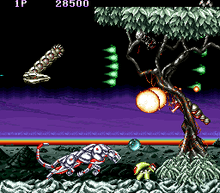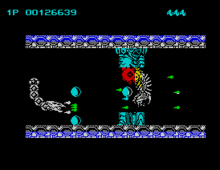Saint Dragon
Tenseiryuu: Saint Dragon (天聖龍 SAINT DRAGON) is a horizontally scrolling shooter released as a coin-op by Jaleco in 1989.[1] Ports to several home computer systems were published by Storm Entertainment in 1990.
| Tenseiryuu: Saint Dragon | |
|---|---|
| Developer(s) | NMK |
| Publisher(s) | Jaleco Storm Entertainment (ports) |
| Platform(s) | Arcade, Amiga, Amstrad CPC, Atari ST, Commodore 64, PC-Engine, ZX Spectrum, MSX |
| Release | 1989 |
| Genre(s) | Scrolling shooter |
| Mode(s) | Single-player |
Gameplay

Saint Dragon is a side-scrolling shoot 'em up in which the player controls the cyborg Saint Dragon, who has rebelled against the tyrannical Monster Cyborg army. Saint Dragon is initially armed with plasma bolts and a fiery breath. By collecting tokens, the dragon's firepower can be upgraded with pulse torpedoes, a laser, bouncing bombs, ring lasers or a turret. Other tokens can upgrade the dragon's speed, weapon power, or initiate a "hyper" mode which endows maximum firepower and invulnerability. In addition, the dragon has an armoured tail which follows the player's movement, allowing it to be used as a defensive shield.
There are five levels, each culminating in a battle with a large end-of-level guardian.
Ports
Storm were a software development team for The Sales Curve (Silkworm, The Ninja Warriors), who were affiliated with Accolade. The conversion project was managed by Dan Marchant, with programming by Andrew Taylor, music by Tony Williams, and graphics by Sean McClurg. Before working on the ZX Spectrum conversion, Taylor spent two weeks reading reviews of other scrolling games and studied videos of the arcade board gameplay.[2] He noted several challenges: "There are some huge sprites in here, some half the size of the screen, which use up a vast amount of memory. The other thing is that in St Dragon each alien seems to make a much more complicated series of moves than in, say, R-Type, so we've got to try and reproduce them all, which is pretty complicated." [1] He also wanted to achieve smooth scrolling, rather than the by-character-block movement in R-Type, without sacrificing speed. A method called "pre-shifts" was eventually used, in which several versions of a sprite are held in memory, each in a slightly different position, then cycled through to give the appearance of smooth movement. This used up more memory, so he restricted the game to the 128K models of Spectrum. The larger sprites, such as the leaping Puma, were handled by dividing them into strips of separate but co-ordinated entities.[2]
Reception

In Japan, Game Machine listed Saint Dragon on their April 1, 1989 issue as being the sixth most-successful table arcade unit of the year.[3]
The ZX Spectrum conversion was well-received on its initial release. CRASH awarded it 92%, finding the dragon theme to be a refreshing change in the genre. The graphics were highlighted as well-animated, smooth and colourful.[4] Your Sinclair awarded 80%, criticizing the uneven difficulty and low number of levels but praising it as "pretty, tough and a blast-a-minute".[5]
On its budget re-release in 1992, Your Sinclair adjusted their rating to just 29%, criticizing it as "hideously slow, graphically abysmal, impossibly tedious load of old junk". Stuart Campbell took issue with the cassette multi-load, the invisible border on the reduced playing area, and framerate drop when multiple sprites are on-screen.[6]
References
- Bielby, Matt (October 1990). "St Dragon Preview". Your Sinclair. Future Publishing (58).
- "Blue Print: Saint Dragon". Sinclair User. EMAP images (105): 74–75. November 1990.
- "Game Machine's Best Hit Games 25 - テーブル型TVゲーム機 (Table Videos)". Game Machine (in Japanese). No. 353. Amusement Press, Inc. 1 April 1989. p. 25.
- "St Dragon Review". CRASH. Newsfield (82): 46. November 1990.
- Hamza, Kati (December 1990). "St Dragon Review". Your Sinclair. Future Publishing (60).
- Campbell, Stuart (June 1992). "St Dragon Review". Your Sinclair. Future Publishing (78).
External links
- Saint Dragon at Atari Mania
- Interview with Amiga programmer John Croudy